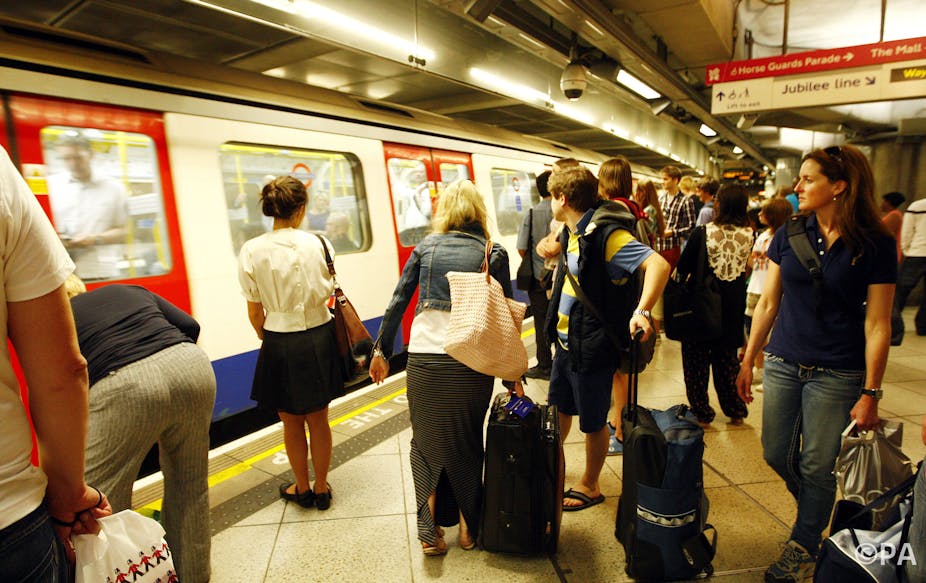Any traveller on the London Underground during the summer will know how hot and stifling it can get. That the Tube can be hotter than Bali or Barcelona is a fact of life for commuters.
Running trains in small, deep tunnels means temperatures are well above those on the surface, [even in the winter](http://dx.doi.org/10.1016/j.applthermaleng.2003.10.017](http://dx.doi.org/10.1016/j.applthermaleng.2003.10.01). Lighter trains, improved brakes that generate less heat and ventilation systems can help cut areas where heat builds up, but there will always be some waste heat generated, especially in deeper routes such as the Northern and Central lines.
While Transport for London has maintained a programme of works to try to cool the tube for years, at the same time there has been a growing realisation, most recently in a report for the Mayor of London, that waste heat could be harnessed as a form of energy to heat buildings.
There’s an opportunity here: TfL needs to get rid of the Tube’s underground heat, and there are many people above ground who could use it. With the rising costs of household energy bills, recovering and putting the heat to good use looks like a sensible, feasible prospect. However, there are several challenges in implementing such a system – not least how to extract the heat, how to get it to where it could be useful, how much it would cost, and who pays.
Making good use of the heat we find
Within the Underground there are two possible locations where heat recovery has been considered: stations and air shafts. Recovering heat directly from the train tunnels is difficult because of gaining access to install and maintain equipment, and the potential to disrupt services. This could probably only be considered during the construction of new tunnels, or total renovation of old tunnels.
Station heat recovery is attractive as a large amount of heat is generated and given off from trains’ brakes when stopping at the platform. Heat could be removed using exchanging devices such as an air handling unit, which London Underground has developed for cooling, or heat transfer panels on walls.
Both function by using water to transfer the heat to where it usefully required. At Green Park station, for example, cold water is passed through the warm air, taking the heat away from the station and into the ground. Instead, the warmed water could be pumped elsewhere for heating before being returned.
Laying the pipes
These are significant financial and logistical undertakings. Certainly any widespread deployment of such systems would be costly and require significant political support. A more pragmatic example exists on the Paris Métro where heat exchangers were installed into station passages to transfer heat to a district heating system in a housing development which, being adjacent, didn’t require significant construction.
London Underground, like all underground railways, has ventilation shafts to supply fresh, cool air or remove stale, warm air. Shafts that extract air have the potential to recover heat. One way would be to take the air directly to the potential user, which would mean the recipient would need to be close to the shaft and, given the shaft size, their building designed with this in mind.
An alternative is to install a heat exchanger in the airshaft to remove heat from the air, for example through water, which then could be piped to a user. This second option is more flexible and allows for more control, and is similar to the system to be used in the recently announced project to supply heat from the Underground to the Bunhill Estate heat and power network in Islington, London.
Sharing benefits, sharing costs
Using ventilation shaft heat recovery won’t benefit the Tube network, as it only uses heat that was on its way out of the system already. This would suggest it would be the energy user who took on most of the costs from using heat from the Tube. If and when London Underground considers installing station cooling, they should consider the potential for heat recovery, but this type of project could not be initiated on the basis of heat recovery alone.
Constructed over more than a century, the variability in design and configuration of the Underground network means any adoption of heat recovery needs to be judged case by case. The proximity of a station or shaft to potential users, the users’ energy costs, their heating demand and London Underground’s plans for station cooling will be important in determining where a project could take place and whether it will be viable.
The widespread adoption of heat recovery from the London Underground faces many challenges. But if both building owners and developers along with London Underground consider heat recovery as a normal part of project design then there is a greater possibility for future adoption, when potential benefits exist.

